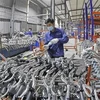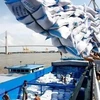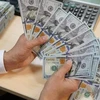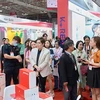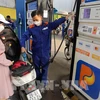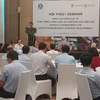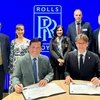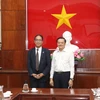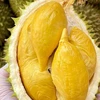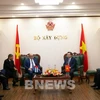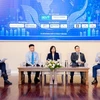Low value adds, poor quality of exports and heavy dependence on raw material imports along with poor processing facilities and transportation were affecting the country's export quality and efficiency.
Nguyen Thi Thu Hang, senior technical consultant at Export Potential Assessment (EPA), told a conference in Hanoi on July 30 that limited understanding about foreign markets and international trade issues and inadequate market information, poor supply chain and sector linkages as well as outdated production and processing technologies for export products are also problems plaguing the country's exports.
EPA is the first major activity of the four-year "Decentralised Trade Support Services for Strengthening the International Competitiveness of Vietnamese Small and Medium-sized Enterprises" programme, being implemented nationally by the Trade Promotion Agency.
In order to deal with these issues, Hang emphasised on the importance of promoting the implementation of the State's preferential policies in support industries to solve input material shortages.
Besides, to enhance linkages in supply chains to reduce cost, improving product quality and competitiveness of exports, diversifying export markets and accelerating trade promotion were also necessary, she said.
She added that improving the capacity of domestic enterprises in negotiating, contracting and getting international transactions reduced should be also included.
On his speech at the event, Deputy Minister of Industry and Trade Do Thang Hai said Vietnam was attempting to increase exports of high-value goods while reducing shipments of raw materials abroad.
The country was also fostering its negotiations of Free Trade Agreements with foreign countries to expand export outlets, he said.
In the future, it was necessary to identify and assess products and services which had an export potential and then focus on accelerating exports of these goods, he noted.
According to a report which was also released at the July 30 conference, the items with high export potentials in the short to medium terms were coffee, rubber and cassava along with pepper, garments and leather shoes. Seafood such as tuna and shrimp were also on the list. Electronics, textiles and garment, and wooden goods apart from bamboo and rattan products, were also items with high export potential. Tourism and labour were items on the list.-VNA
Nguyen Thi Thu Hang, senior technical consultant at Export Potential Assessment (EPA), told a conference in Hanoi on July 30 that limited understanding about foreign markets and international trade issues and inadequate market information, poor supply chain and sector linkages as well as outdated production and processing technologies for export products are also problems plaguing the country's exports.
EPA is the first major activity of the four-year "Decentralised Trade Support Services for Strengthening the International Competitiveness of Vietnamese Small and Medium-sized Enterprises" programme, being implemented nationally by the Trade Promotion Agency.
In order to deal with these issues, Hang emphasised on the importance of promoting the implementation of the State's preferential policies in support industries to solve input material shortages.
Besides, to enhance linkages in supply chains to reduce cost, improving product quality and competitiveness of exports, diversifying export markets and accelerating trade promotion were also necessary, she said.
She added that improving the capacity of domestic enterprises in negotiating, contracting and getting international transactions reduced should be also included.
On his speech at the event, Deputy Minister of Industry and Trade Do Thang Hai said Vietnam was attempting to increase exports of high-value goods while reducing shipments of raw materials abroad.
The country was also fostering its negotiations of Free Trade Agreements with foreign countries to expand export outlets, he said.
In the future, it was necessary to identify and assess products and services which had an export potential and then focus on accelerating exports of these goods, he noted.
According to a report which was also released at the July 30 conference, the items with high export potentials in the short to medium terms were coffee, rubber and cassava along with pepper, garments and leather shoes. Seafood such as tuna and shrimp were also on the list. Electronics, textiles and garment, and wooden goods apart from bamboo and rattan products, were also items with high export potential. Tourism and labour were items on the list.-VNA
